Disclosure: I received samples of Everlast Vegan Protein because I am a BibRave Pro and because I am a fitness professional member of IDEA. Learn more about becoming a BibRave Pro here. Read and write race reviews at BibRave.com!
As many of you know, I eat vegetarian and have been trying to reduce my egg and dairy intake. As part of my quest to keep a healthy, balanced diet I’ve been in search of a vegan protein powder. Since I drink Shakeology daily, I don’t need a protein powder with added nutrition–I’m just looking for the protein, thanks. I jumped at the chance to try Everlast Vegan Protein!
After I received the samples, I bought the full-sized bag, so you can enter to win those samples. (There is a great sale on right now–the regular price is $68.99, the sale price is $39.99–plus I saved 5% with code TRAINWITHBAIN and scored free shipping and a shaker cup.)
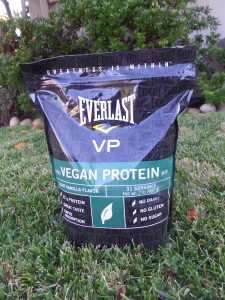
Everlast Vegan Protein currently comes in one flavor, “light vanilla flavor.” It has no dairy, no gluten, no sugar, and no soy. If you have severe allergies, you should know it is made or packaged in a facility that also handles products made with milk, eggs, wheat, and soy (and the package has the required FDA allergen warning on it).
Ingredients. Many protein powders either have a bunch of weird or unnecessary additives. Yes, protein powder is a highly processed food, but I still like to know what is in it and make the best possible choices.
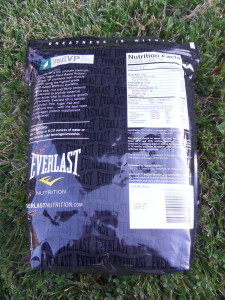
- Pea protein
- Carrageenan
- Sea Salt
- Natural flavor
- Rice protein
- Hemp protein
- Stevia glycoside
The protein blend includes yellow pea protein, rice protein, and hemp protein. This mix avoids the most common allergens (e.g. soy) while delivering a protein that covers a complete BCAA profile. (Branched-Chain Amino Acids–BCAAs–are the building blocks of protein: leucine, isoleucine, and valine. You can read more about what BCAAs do on the Precision Nutrition site.)
What about the non-protein ingredients? Sea salt is exactly what you think it is. The term “natural flavor” is regulated by the FDA, and is used on the labels of many food products and supplements–and since this protein powder has a flavor, the label has to identify it. If you really want the technical definition, here it is, direct to you from the Code of Federal Regulations:
The term natural flavor or natural flavoring means the essential oil, oleoresin, essence or extractive, protein hydrolysate, distillate, or any product of roasting, heating or enzymolysis, which contains the flavoring constituents derived from a spice, fruit or fruit juice, vegetable or vegetable juice, edible yeast, herb, bark, bud, root, leaf or similar plant material, meat, seafood, poultry, eggs, dairy products, or fermentation products thereof, whose significant function in food is flavoring rather than nutritional.
Since this is a vegan protein, you know the flavor isn’t from meat, seafood, poultry, eggs, or dairy products. (I know, you’re thinking, “why not just say ‘vanilla’?” My guess? That’s complicated, as in there are separate sections of the Code of Federal Regulations with specifications for vanilla. Title 21, Part 169, Subpart B defines: § 169.176 Concentrated vanilla extract; § 169.177 Vanilla flavoring; § 169.178 Concentrated vanilla flavoring; § 169.179 Vanilla powder; § 169.180 Vanilla-vanillin extract; § 169.181 Vanilla-vanillin flavoring; and § 169.182 Vanilla-vanillin powder. Vanilla is derived from a variety of orchids from the genus vanillia; different flowers grown in different parts of the world produce different flavors. If you want to keep the taste of your product consistent, ideally you’d use the exact same type of vanilla flavor…but vanilla is a picky little diva of a flower that can only be grown in certain places. Any change in the flowers could change the flavor, which means re-sourcing the vanilla. Re-sourcing the vanilla could mean changing from one type of regulated flavor to another–for example from extract to powder–which would require a change in the label, which would lead to a delay in production. In other words, major pain in the butt.)
That leaves carrageenan and stevia glycoside. The dairy industry has worked hard to demonize carrageenan through production of commercials about nut milks. (Backstory: the biggest dairy producers and processors convinced some legislators to introduce a bill that would limit use of the word “milk” to dairy products; they are unhappy that in the current nutritional climate, many people are turning to soy milk, almond milk, rice milk, and similar beverages. When this bill failed, they started to run commercial advertising to influence public opinion by providing just one tiny slice of information about non-dairy milks. Basically, sore losers.) Carrageenan is derived from red seaweed. The Irish began using it in food hundreds of years ago (if not earlier–there’s only so much history we can trace). The Food Babe points to it as one of the most evil things in food, but she relies on animal-only studies that studied poligeenan (which is a different substance) and studies that used huge amounts (more than you’d consume even if you ate all-processed, all the time). (You can read one simple counterpoint to the fear-mongering at the International Food Information Council site. Click the links, use Google Scholar and PubMed, and understand the science.) Carrageenan serves two functions in a protein powder. One, it preserves the nutritional value of the protein. Two, it allows the protein to suspend evenly in liquid, instead of clumping up and floating to the top or sinking to the bottom.
Finally, stevia glycoside. Steviol glycosides are the compounds in the Stevia rebaudiana Bertoni plant–at least ten of them–that make the plant sweet. Pure stevia actually has a bitter aftertaste, which is why commercial sweeteners containing stevia usually don’t contain much stevia–and why Truvia (which is like 95% erythritol, a sugar alcohol) is being sued for misleading consumers. The difference is important; stevia, which has been used for over 100 years as a sweetener, does not have an impact on blood sugar, while some sugar alcohols not only impact blood sugar but also affect gut bacteria and may cause intestinal upset in sensitive individuals. You can read more than you ever wanted to know about stevia from the International Stevia Council. (Yes, it is their job to make stevia sound awesome. Feel free to cross reference with Google Scholar and Pub Med.) Oh, and the amount of stevia added is just enough to make Everlast Vegan Protein not-sour, not-salty. This isn’t a sugar bomb “tastes like a cake mix” product.
My kitchen is the laboratory: Touch Test. Okay, so this might not technically be a test, exactly, but in my experience the texture of the mix affects the final product. The protein powders my brother used in high school were gritty and felt like they contained bits of ground-up gravel in them. The resulting sludges had a sandy texture to them, and any un-mixed lumps brought me right back to falling off the swingset and doing a face plant in the sandbox. Yuck. Birds need to eat gravel and grit, but I surely don’t!
Thankfully, there is no sandy, gritty stuff in Everlast Vegan Protein powder. The dry texture is more like a weightier powdered sugar, or a very soft and creamy powdered makeup. While in the sealed bag, you can almost knead it like bread dough.
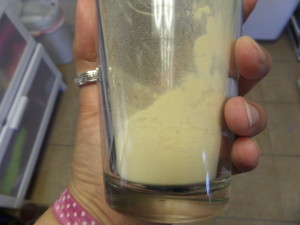
My kitchen is the laboratory: Mix Test. The first test I perform on any drink or protein powder is a mix test: I take the full serving size, put it into a pint glass, and add either water (for fruity-flavored supplements) or skim milk (for protein powder), then stir with a spoon. I don’t always have a shaker cup with me, and sometimes you need to adjust serving sizes to get an optimal mix. Yes, I realized while I was stirring that it is a little ironic that my first test on a vegan protein powder is to mix it with dairy milk. Oops.
The majority of the protein powder mixed thoroughly and dissolved. In hindsight, the amount of space the protein powder took up in the glass means it is unlikely I got the recommended 8 to 12 ounces of liquid in there. Oops. There were a few globs of not-quite-dissolved powder; when I tasted them, they were smooth, like a thick pudding (not at all gritty like my brother’s high school sludges). The resulting protein drink was smooth and had a nice texture. To my surprise it was also very filling, even though a single serving is only 110 calories (plus the approximately 90 calories in the 8 ounces or so of skim milk I put in there).
The flavor was light, as described on the package. It didn’t scream VANILLA! like some vanilla-flavored things. Personally, I consider this a major win, as my search for a protein powder is in part so I can add it to recipes and shakes where I don’t want it to overpower the other ingredients.
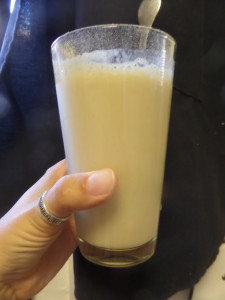
My kitchen is the laboratory: Blender Test. At IDEA World last year, I stopped by the Ninja Kitchen booth, had some delicious green juice, entered a twitter contest, and won a Ninja Ultima! The blender is now my go-to appliance (because it works like a ninja, and because it is so easy to clean) and I use it pretty much every day to make a breakfast smoothie using the single-serve Nutri Ninja cups. Since the mix test above convinced me that I needed more liquid for a full scoop of Everlast Vegan Protein, I made one of my usual recipes and added a half scoop (without changing anything else about the recipe). I was a little afraid that I should have added the liquid first–some of the powder hit the bottom of the cup, and I wasn’t sure whether the Ninja could get it fully mixed-in, given the softness of the product.
Fortunately the Ninja worked like a champ, and the Everlast Vegan Protein blended into the smoothie 100% (no unblended bits). The smoothie tasted pretty much like I expected it to taste, with a subtle hint of vanilla in there. I could definitely tell I had added more protein, as the smoothie had a little more weight to it, and I felt sated longer than I usually do after a smoothie.
The not-so-good. The only downside to Everlast Vegan Protein is the packaging. (I was going to add the flavor–there’s a thing called “flavor fatigue” if you always have the same thing–but the flavor is so light that you can add anything to it, or add it to anything, and come up with a million tasty flavors.) I like that the packaging is minimal, just a single, theoretically re-seal-able bag. I’m trying to cut down on how much trash I generate, and since I own plenty of portable containers and such there isn’t any reason why I should need individually-wrapped servings. I like that it’s not a giant plastic canister like most other brands of protein, as those take up way too much space in my kitchen and are usually about 25% larger than necessary.
I count the packaging as a downside, because the ziploc-style re-seal-able top is incompatible with the product. When I tried to re-seal the bag, the single set of grooves refused to mate and seal; both sides of the bag had the fine dust of Everlast Vegan Protein thoroughly filling in the groove. No matter how much I tried, I couldn’t get the bag to seal shut again. This led me to dump the bag into a Tupperware-type square container with a tight-fitting lid. Unfortunately, the fluffy texture of the powder meant that even though I tried to prevent any giant dust-poof (if you’ve ever poured flour into a storage jar, or tried to seal a flour bag shut, you’ve met the dust-poof), the product got all over my counter and myself. Oops. Now that it is in the container, and I’ve washed and dried the scoop (which I put into the container with the handle OUT of the product), I’m good to go.
WIN WIN WIN!
Since I went all-in and bought the two pound Everlast Vegan Protein bag, I don’t need the samples. Since I have a bit of a drinking vessel habit–seriously, I can’t resist a cute water bottle or shaker cup–I don’t need the shaker cup either. (Trust me, it pains me to give this one away, but I’m trying SO HARD not to turn into my packrat Nana.) This giveaway features TWO prizes! Prize #1: two samples of Everlast Vegan Protein. Prize #2: two samples of Everlast Vegan Protein plus an Everlast shaker cup.
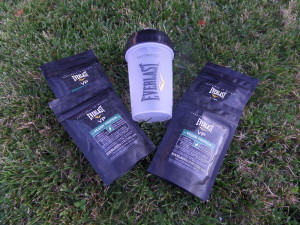
P.S. remember there is a great sale on right now–the regular price is $68.99, the sale price is $39.99–plus I saved 5% with code TRAINWITHBAIN and scored free shipping and a shaker cup. (That code is good on anything on the Everlast Nutrition site, and does not expire.)
P.P.S. Want to see what the other BibRave Pros thought about Everlast Vegan Protein?
24 Comments
Pingback: Angie Runs | Everlast Vegan Protein Powder – Review
Pingback: Everlast VP Pro Vegan Protein Mix – Brie
I LOVE that you did such amazing research on the ingredients and labeling! Thank you so much for diving in to this and sharing with the rest of us!
Thanks, Allison. I’m a big ol’ nerd at heart, so this kind of research makes me giddy!
Pingback: Races and Rescues Product Review: Everlast Vegan Protein - Races and Rescues
Pingback: Shake it like it’s hot – Everlast VP Pro Vegan Protein Mix Review | Running to Happiness
Pingback: Product Review: Everlast Vegan Protein | Darlin' Rae
I have not, but would love to!
Have you tried other protein powders (non-vegan ones)?
I haven’t tried any vegan protein powders but would love to try this.
Just like the whey-based ones, there are some vegan proteins that are tasty, and others that taste like dirt. This one’s definitely my new fave.
I love Vega protein products but always looks for new products to try!
I haven’t tried Vega protein, but I have tried their pre- and post- workout beverages. Vega’s recovery accelerator mix is in my cupboard! I reviewed the line awhile back, you can find the review HERE. Have you tried those?
Thanky Thanky for all this good infirmatoon!
Never tried a vegan powder, so I’d like to give this a shot.
Do you mostly use protein powder in shakes, or do you also cook or bake with it?
I have not tried a vegan protein and these sound yummy! Thank you!
I have tried other vegan protein powders. I have had several with great flavors and ingredients, but I have never tried this brand.
Of the ones you have tried, which ones did you like the best?
I have tried the Garden of Life raw protein. The gritty texture I did not care for.
I haven’t tried this stuff. what flavors do you like?
Right now it only comes in “light vanilla.” I think that’s ideal, since the mild flavor allows you to add whatever you like to provide the flavor–cocoa, fruit, peanut butter, etc.
I’ve only had whey protein so I’d be interested in trying a vegan one.
I have tried other vegan proteins, I like them for the most part